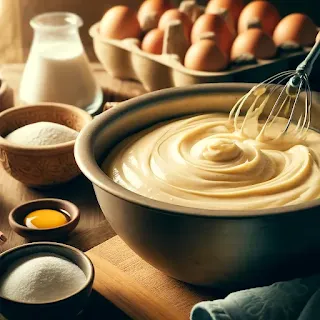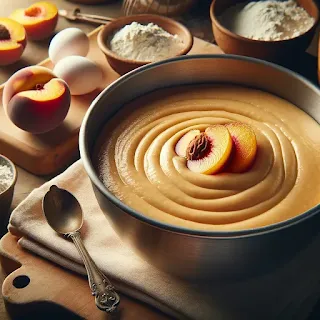These Pistachio Rosewater Cookies are a delightful Middle Eastern-inspired treat. The combination of finely ground pistachios and fragrant rosewater creates a unique flavor that’s perfect for any occasion.
Origin Story: Pistachio Rose Cookies
Pistachio Rose Cookies are an elegant and aromatic treat that blends the nutty richness of pistachios with the delicate floral notes of rose water. This combination creates a cookie that is both unique and delightful, evoking the flavors and aromas of Middle Eastern cuisine.
Historical Roots
Pistachios have been cultivated for thousands of years, originating in the Middle East and Central Asia. They were a favorite of ancient royalty, often used in both sweet and savory dishes. The pistachio's rich, buttery flavor and vibrant green color make it a prized ingredient in many traditional Middle Eastern desserts.
Rose water, another key ingredient, has a long history in the culinary traditions of the Middle East, India, and Iran. Made from the distillation of rose petals, rose water has been used for centuries to flavor sweets, beverages, and even savory dishes. Its delicate floral aroma and subtle flavor add a touch of elegance to any dish.
Cultural Significance
The combination of pistachios and rose water is a classic in Middle Eastern cuisine, often found in dishes such as baklava, Turkish delight, and various pastries. These ingredients are symbolic of luxury and celebration, frequently used in desserts prepared for special occasions and festivals.
Pistachio Rose Cookies bring together these traditional flavors in a modern, accessible form. They are perfect for tea parties, festive gatherings, or as a sophisticated treat to enjoy at any time.
Personal Connection
My journey with Pistachio Rose Cookies began during a visit to a bustling bazaar in Istanbul. The air was filled with the scents of spices, nuts, and flowers. Among the many stalls, I came across a vendor selling a variety of traditional sweets. One bite of their pistachio and rose-flavored pastries was enough to inspire me to recreate those flavors at home.
Back in my kitchen, I started experimenting with different recipes, aiming to capture the essence of those market treats in a simple cookie. The key was to balance the flavors so that neither the pistachios nor the rose water overwhelmed the other. After several trials, I found the perfect ratio that brought out the best in both ingredients.
Recipe Evolution
Creating the ideal Pistachio Rose Cookie involved fine-tuning the texture and flavor. I discovered that using finely ground pistachios in the dough provided a rich, nutty base, while chopped pistachios added a pleasant crunch. The addition of rose water had to be just right—too much and the cookies would taste perfumey, too little and the delicate floral note would be lost.
To enhance the cookies further, I sometimes top them with a light rose glaze or sprinkle them with crushed pistachios before baking. These little touches add to the visual appeal and depth of flavor, making each cookie a little work of art.
Sharing the Tradition
Today, Pistachio Rose Cookies are a favorite in my home and among my friends. They are the cookies I bake when I want to impress guests with something both beautiful and delicious. Each bite is a reminder of my journey through the vibrant bazaars and the joy of discovering new flavors.
Ingredients
- 1 cup unsalted butter, softened
- 1 cup granulated sugar
- 1 large egg
- 1 teaspoon vanilla extract
- 1 teaspoon rosewater
- 2 cups all-purpose flour
- 1/2 teaspoon baking powder
- 1/4 teaspoon salt
- 1 cup finely ground pistachios
- Extra pistachios for garnish
- Preparation Time: 15 minutes
- Cooking Time: 15 minutes
- Yield: 24 cookies
Instructions
Prepare the Dough:
- Preheat the oven to 175°C (350°F).
- In a large bowl, cream together the butter and sugar until light and fluffy.
- Beat in the egg, vanilla extract, and rosewater.
Mix Dry Ingredients:
- In a separate bowl, whisk together the flour, baking powder, and salt.
- Gradually add the dry ingredients to the wet mixture, mixing until combined.
- Stir in the finely ground pistachios.
Shape and Bake:
- Roll the dough into 1-inch balls and place them on a baking sheet lined with parchment paper.
- Flatten each ball slightly and press a whole pistachio into the center of each cookie.
- Bake for 12-15 minutes, or until the edges are golden.
Pro Tips
- Chilling the Dough: For easier handling, chill the dough for 30 minutes before shaping.
- Even Baking: Rotate the baking sheet halfway through baking to ensure even browning.
Secret Tips
- Enhanced Flavor: Add a pinch of cardamom to the dough for a subtle spice.
- Decoration: Dust the cookies with powdered sugar for an elegant touch.
Serving Options
- Serve these cookies with a cup of tea or coffee for a delightful afternoon treat.
Variations & Customization Options
- Lemon Zest: Add a teaspoon of lemon zest to the dough for a citrusy twist.
- Chocolate Drizzle: Drizzle melted dark chocolate over the cooled cookies for added indulgence.
These Pistachio Rosewater Cookies offer a unique and flavorful twist on traditional cookies. Their delicate aroma and rich nutty taste make them a perfect addition to any cookie platter.
Enjoy baking and sharing this delightful treat!
Sam













